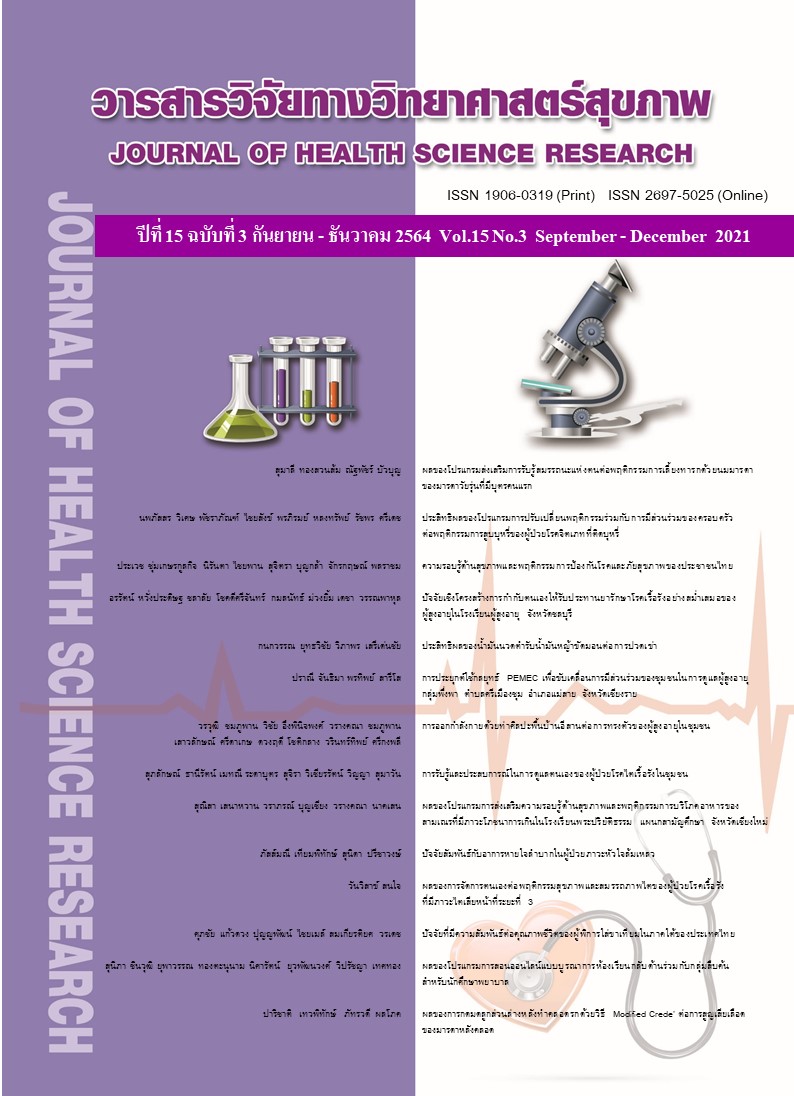ปัจจัยที่มีความสัมพันธ์ต่อคุณภาพชีวิตของผู้พิการใส่ขาเทียม ในภาคใต้ของประเทศไทย
Main Article Content
บทคัดย่อ
บทนำ : การถูกตัดขาเป็นการสูญเสียที่ยิ่งใหญ่ ก่อให้เกิดเป็นความพิการ เป็นภาระทางสุขภาพที่สำคัญ แม้ว่าจะได้รับขาเทียมเพื่อให้กลับมาใช้ชีวิตประจำวัน แต่ก็ปฏิเสธไม่ได้ว่าการถูกตัดขาส่งผลกระทบหลายด้าน รวมถึงคุณภาพชีวิต
วัตถุประสงค์การวิจัย : เพื่อศึกษาระดับคุณภาพชีวิตและปัจจัยที่มีความสัมพันธ์ต่อคุณภาพชีวิตของ
ผู้พิการใส่ขาเทียม
วิธีการวิจัย : การศึกษาเชิงวิเคราะห์ภาคตัดขวาง ตัวอย่าง คือ ผู้พิการใส่ขาเทียม จำนวน 315 คน สุ่มตัวอย่างด้วยวิธีการแบ่งกลุ่ม เก็บข้อมูลด้วยแบบสอบถามคุณภาพชีวิตขององค์การอนามัยโลกชุดย่อ ฉบับภาษาไทย วิเคราะห์ข้อมูลด้วยสถิติเชิงพรรณนา และวิเคราะห์ปัจจัยที่มีความสัมพันธ์ต่อคุณภาพชีวิตของผู้พิการใส่ขาเทียมด้วยสถิติถดถอยโลจิสติกพหุตัวแปร
ผลการวิจัย : ผู้พิการใส่ขาเทียมมีคุณภาพชีวิตภาพรวมอยู่ในระดับดี (64.76%; M±SD=101.31± 14.12) และพบว่าปัจจัยที่มีความสัมพันธ์ต่อคุณภาพชีวิตของผู้พิการใส่ขาเทียมอย่างมีนัยสำคัญทางสถิติ ได้แก่ เพศหญิง (Adjusted OR [ORadj] = 0.33, 95%CI: 0.17-0.70) ผู้ประกอบอาชีพค้าขายหรือธุรกิจส่วนตัว (ORadj = 9.09, 95%CI: 2.24-36.76) สาเหตุการถูกตัดขาจากอุบัติเหตุ (ORadj = 7.36, 95%CI: 3.13-17.30) ปัญหาตอขา (ORadj = 0.22, 95%CI: 0.92-0.53) การมีรายได้เพียงพอ (ORadj = 6.91, 95%CI: 3.28-14.57) การมีสัมพันธภาพที่ดีภายในครอบครัว (ORadj = 3.20, 95%CI: 1.01-10.11) และความต้องการช่วยเหลือในการทำกิจวัตรประจำวัน (ORadj = 0.34, 95%CI: 1.14-0.79)
สรุปผล : ผู้พิการใส่ขาเทียมมีคุณภาพชีวิตอยู่ในระดับดี และปัจจัยด้านเพศ อาชีพ สาเหตุการถูกตัดขา ปัญหาตอขา รายได้ สัมพันธภาพในครอบครัว และการทำกิจวัตรประจำวัน มีความสัมพันธ์ต่อคุณภาพชีวิตของผู้พิการใส่ขาเทียม
Downloads
Article Details
บทความที่ได้รับการตีพิมพ์เป็นลิขสิทธิ์ของวิทยาลัยพยาบาลบรมราชชนนี จังหวัดนนทบุรี
ข้อความที่ปรากฏในบทความแต่ละเรื่องในวารสารวิชาการเล่มนี้เป็นความคิดเห็นส่วนตัวของผู้เขียนแต่ละท่านไม่เกี่ยวข้องกับวิทยาลัยพยาบาลบรมราชชนนี จังหวัดนนทบุรี และคณาจารย์ท่านอื่น ในวิทยาลัยฯ แต่อย่างใด ความรับผิดชอบองค์ประกอบทั้งหมดของบทความแต่ละเรื่องเป็นของผู้เขียนแต่ละท่าน หากมีความผิดพลาดใด ๆ ผู้เขียนแต่ละท่านจะรับผิดชอบบทความของตนเองแต่ผู้เดียว
เอกสารอ้างอิง
Wanchai A, Chaisa P, Srinon R. Nursing care of patients with amputation.Chiangrai Medical Journal. 2017;2(9):139-46. (in Thai).
Guy’s and St Thomas’ NHS Foundation Trust. Rehabilitation after your lower limb amputation [Internet]. 2018 [cited 2019 Jan 10]; Available from https://www.guy sandstthomas.nhs.uk/resources/patientinfor rmation/therapies/rehabilitation-after-your-leg-amputation.pdf.
Sahu A, Sagar R, Sarkar S, Sagar S. Psychological effects of amputation: a review of studies from India. Ind Psychiatry J. 2016;25(1):4-10. doi: 10.4103/0972-6748.196041.
Gailey R, Allen K, Castles J, Kucharik J, Roeder M. Review of secondary physical conditions associated with lower-limb amputation and long-term prosthesis use. J Rehabil Res Dev. 2008;45(1):15-29. doi: 10.1682/jrrd.2006.11.0147.
Ziegler-Graham K, MacKenzie EJ, Ephraim PL, Travison TG, Brookmeye R. Estimating the prevalence of limb loss in the United States: 2005 to 2050. Arch Phys Med Rehabil. 2008;89(3):422-9. doi: 10.1016/j.apmr.2007.11.005.
Social Statistics, Division National Statistical Office. The 2017 disability survey. Bangkok: Text and Journal Publication; 2020. (in Thai).
Yesuwan T, Uppayothin P, Jivacate T. Thai lower limb amputees: stigma process and adaptation. ASEAN Journal of Rehabilitation Medicine. 2012;22(2): 51-7. (in Thai).
Sakthong P. Health related quality of life. Bangkok. Chulalongkorn University Press; 2011. (in Thai).
Kaewdoung S, Woradet S, Chaimay B. Quality of life among individuals with lower limb prosthesis: literature review. UBRE Journal for Public Health Research. 2020;9(2):20-31. (in Thai).
Kamonsawat N. Quality of life of trans-femoral and trans-tibial amputees after receiving Prosthesis at prosthetic and orthotic unit, Rayong hospital. The Journal of Prapokklao Hospital Clinical Education center. 2014;31(1):18-29. (in Thai).
Mahatnirandkul S, Tantipiwattanasakul W, Pumpaisanchai W. The world health organization quality of life indicators, Thai version (WHOQOL-BREF-THAI) [Internet]. 2002 [sited 2018 Sep 24]; Available from https://www.dmh.go.th/ test/whoqol.
Asano M, Rushton P, Miller WC, Death BA. Predictors of quality of life among individuals who have a lower limb amputation. Prosthet Orthot Int. 2008;32(2):23-43. doi: 10.1080/ 03093640802024955.
Sirasaporn P, Manimmanakorn N, Pusiripinyo E. Quality of life of trans-femoral and trans-tibial amputees after receiving prosthesis. ASEAN Journal of Rehabilitation Medicine. 2010;20(1):4-9. (in Thai).
Dajpratham P, Tantiniramai S, Lukkanapichonchut P. Health related quality of life among the Thai people with unilateral lower limb amputation. J Med Assoc Thai. 2011;94(2):250-5.
Angsuwathana S. Menopause. [Internet]. 2020 [sited 2020 Apr 10]; Available from https://www.si.mahidol.acth/sidoctor/e-pl/ articledetail.asp?id=166.
Demet K, Martinet N, Guillemin F, Paysant J, Andre JM. Health related quality of life and related factors in 539
persons with amputation of upper and lower limb. Disabil Rehabil. 2003;25(9): 480-6. doi: 10.1080/0963828031000090434.
Knežević A, Salamon T, Milankov M, Ninković S, Jeremić Knežević M, Tomašević Todorović S. Assessment of quality of life in patients after lower limb amputation. Med Pregl. 2015;68(3-4):103-8. doi: 10.2298/mpns1504103k.
Phutrakhul P. The quality of life of the people with impairment arsing from community employment and Career promotion. Humanities & Social Science. 2018;35(3):198-215. (in Thai).
Steinberg N, Gottlieb A, Siev-Ner I, Plotnik M. Fall incidence and associated risk factor among people with a lower limb amputation during various stages of recovery : a systematic review. Disabil Rehabil. 2019;41(15):1778-87. doi: 10.10 80/09638288.2018.1449258.
Sinha R, van den Heuvel WJ, Arokiasamy P. Factors affecting quality of life in lower limb amputees. Prosthet Orthot Int. 2011;35(1):90-6. doi: 10.1177/03 09364610397087.
Krainetee M, Dhammasaccakkarn W, Sangkharat U. Family: the social key institutions and roles of holistic human development. Parichart journal, Thaksin University. 2020;33(1):1-16. (in Thai).
Sotthiyapai S, Damsangsawat N, Sirathatnararojana T. Family Counseling Model. The Southern College Network Journal of Nursing and Public Health. 2017;(4)3:282-90. (in Thai).


